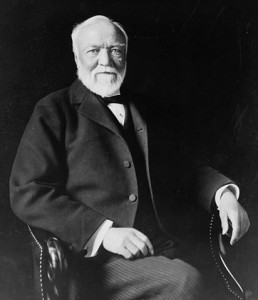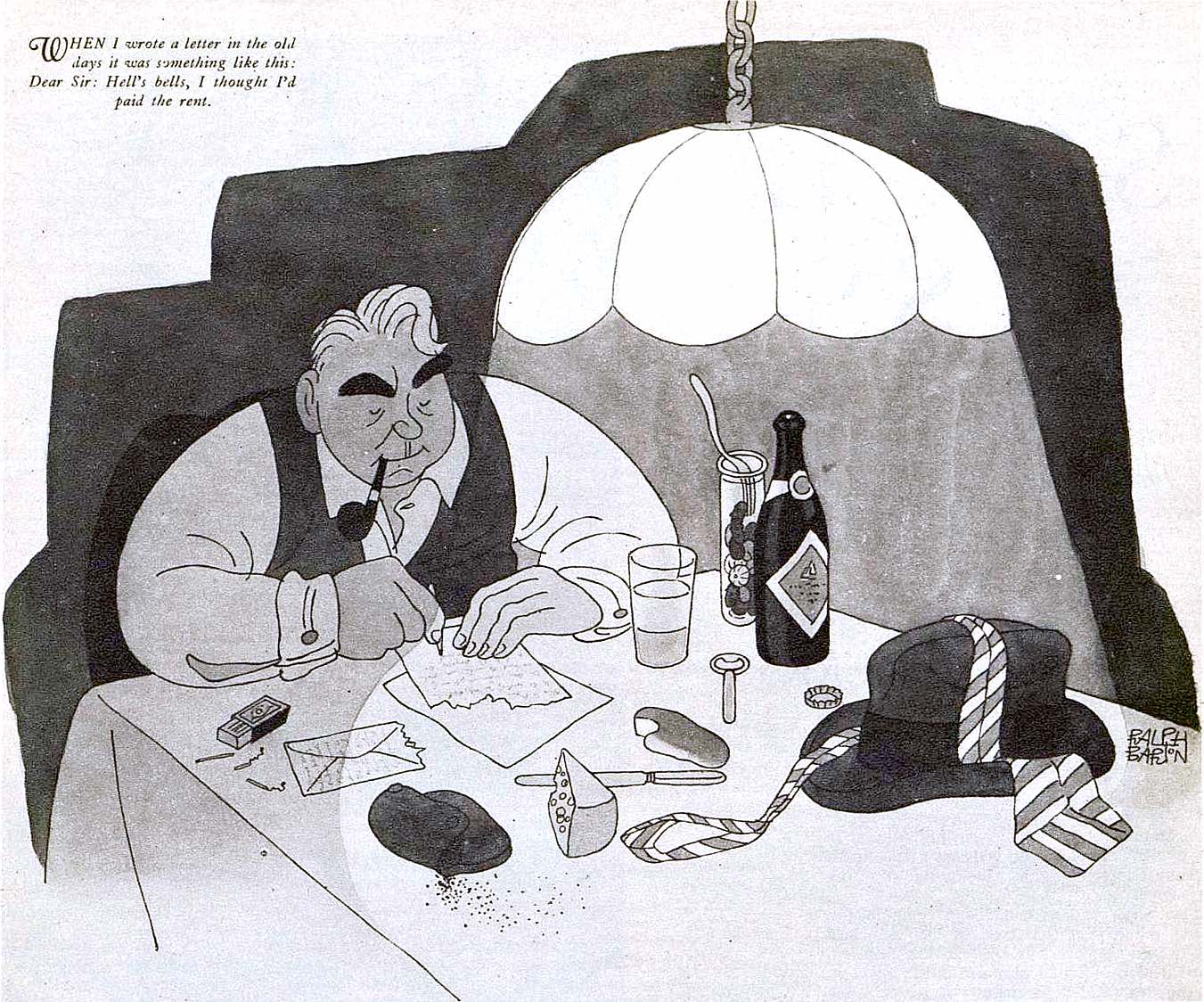 One of the most endearing portraits of Don Marquis was drawn by the brilliant 1920s book and magazine illustrator Ralph Barton. This image appeared in Liberty magazine on Sept. 26, 1925, one of two illustrations for Don’s light-hearted essay “The Curse of Efficiency.” (Scroll down the page for another view of Don by Ralph Barton, from the April 1922 edition of Vanity Fair magazine.)
One of the most endearing portraits of Don Marquis was drawn by the brilliant 1920s book and magazine illustrator Ralph Barton. This image appeared in Liberty magazine on Sept. 26, 1925, one of two illustrations for Don’s light-hearted essay “The Curse of Efficiency.” (Scroll down the page for another view of Don by Ralph Barton, from the April 1922 edition of Vanity Fair magazine.)
Tag Archives: Don Marquis
A Face In the Crowd
Don Marquis ranked in the top tier of Broadway celebrities in early 1922, even though his own comic masterpiece, “The Old Soak,” was still months away from its Broadway premiere (on Aug. 22, 1922). He is pictured here, fat and happy, surrounded by fellow first nighters in a classic Ralph Barton illustration that appeared in the April 1922 edition of Vanity Fair magazine titled “A Typical First Night Audience in New York:—The Scene Which Invariably Confronts the Actor.” Don is seated between Vanity Fair publisher Conde Nast and actress Elsie De Wolfe. In front of him are actress Irene Castle and arts patron Otto Kahn, with the tall, gangly Robert Sherwood in the row behind, to Don’s right. The old sourpuss in the lower-right corner is Don’s nemesis, the Rev. John Roach Straton, an angry fundamentalist minister who eagerly predicted the impending doom of heathen New Yorkers.
The complete, two-page illustration presents 91 spot-on caricatures. It is linked here, with its original key identifying all the celebrities of the day. Barton was famous for his group caricatures, and this one was a precursor to a similarly mammoth piece that appeared in the Jan. 4, 1923, issue of the old Life magazine (linked here) that once again shows Don in the thick of the action. (He’s on the left page, a bit off-center, with Robert Sherwood once again in the row behind, next to a bemused Robert Benchley!)
Something More?
We know Don Marquis today as a humorist (a satirist, really), but perhaps he should be remembered as something more—a humanist? The following lines are from an occasional column Don wrote in 1915 for Outlook magazine.
A LITTLE SYRIAN GIRL
I saw a little Syrian girl in a Brooklyn slum the other day who was sporting a pair of lavender-colored spats. Her stockings were somewhat out of repair; her toes were somewhat out of her shoes; the spats themselves had seen better feet; they had begun life as the spats of some one else, and they were too large for her. But they were spats—and she was happy.
She might have been happier if she could have danced. There was an organ-grinder on the block and other children were dancing. But when this particular little girl tried to dance the spats tripped her, So she gave it up and stood on the curbstone, spatted and superior, conscious Fashion queening it over Terpsichore. Her attitude conveyed that it was all very well for spatless children to dance in the streets, but that she had a certain position to maintain; she felt her social responsibility; if one has spats, one must live up to them. This was her outward attitude; this was the affectation forced upon her by the fact that with those particular spats she could not dance.
But all the while, deep in her ingenuous soul, there must have been stirring a conflict; she must have been debating whether she really wanted to miss the fun for the sake of the spats. In short, were spats worth while after all? Was dignity, eminence, worth the price?
Finally, nature won; affectation succumbed. She removed the spats and joined the dance. But it was too late. In a moment more the organ-grinder was gone. She resumed her spats; for a moment her face conveyed that she felt that she had lost both ways. But only for a moment. Presently the spats reasserted their sway; they communicated to their wearer a strut; she actually managed to strut standing still; to look at her now you would not have guessed that even a momentary doubt concerning spats had ever entered her mind; she became superior again.
I fancy the incident might be worked out on another plane and another scale in other streets. But what I enjoy about human beings is the fact that, no matter where one finds them, they are so human.
* * *
Don Marquis in the News
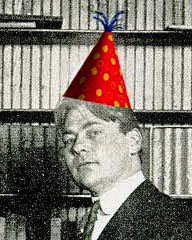 WIT AND WHIMSY: Follow this link for a wonderful birthday tribute to Don Marquis by Bill Knight, a syndicated columnist appearing in the Pekin Daily Times in north-central Illinois. It’s an excellent piece, and well-researched, with quotes from E.B. White, Heywood Broun and Stanley Walker, along with a fine biographical profile.
WIT AND WHIMSY: Follow this link for a wonderful birthday tribute to Don Marquis by Bill Knight, a syndicated columnist appearing in the Pekin Daily Times in north-central Illinois. It’s an excellent piece, and well-researched, with quotes from E.B. White, Heywood Broun and Stanley Walker, along with a fine biographical profile.
Yes, Archy’s name is misspelled in the column, but that’s nothing new. Archy’s name has been consistently misspelled going all the way back to 1916, just a few months after it first appeared in print. And look at any dust jacket of “archy and mehitabel” from 1930 to 1943 and you’ll see “archie” printed on the inside rear flap — an unforgivable error from Don’s publisher, Doubleday.
* * *
 BIRTHDAY BASH: Don’s 141st birthday was Monday, July 29, and it was celebrated in New York with a gathering of the Don Marquis Double Scotch and Prohibition Society at Keens Steakhouse in Midtown Manhattan, one of Don’s old haunts. We are happy to report that the toast of Walnut, Illinois, was toasted in proper fashion — repeatedly — and a good time was had by all. (Click on the photo at right for a closer look.)
BIRTHDAY BASH: Don’s 141st birthday was Monday, July 29, and it was celebrated in New York with a gathering of the Don Marquis Double Scotch and Prohibition Society at Keens Steakhouse in Midtown Manhattan, one of Don’s old haunts. We are happy to report that the toast of Walnut, Illinois, was toasted in proper fashion — repeatedly — and a good time was had by all. (Click on the photo at right for a closer look.)
We have also received correspondence from several far-flung friends of the Society, both foreign and domestic, reporting that they, too, lifted glasses in Don’s honor on his natal day. Anyone with photos (or stories) to share would do the Society a favor by submitting same.
(What is the Double Scotch and Prohibition Society, you say? Follow this link to join the party.)
* * *
 BRONZE EFFIGIES:The New York Times Book Review gave a nod to “archy and mehitabel” in its New & Noteworthy section on Feb. 3 when food writer Melissa Clark called out the carvings of Archy and Mehitabel that sit high above the entrance to the Brooklyn Public Library’s main branch at Grand Army Plaza. Clark told the story of how this bronze cockroach and cat came to be, and who Don Marquis was, and why they, and he, deserve another look today. Here’s a link to her story.
BRONZE EFFIGIES:The New York Times Book Review gave a nod to “archy and mehitabel” in its New & Noteworthy section on Feb. 3 when food writer Melissa Clark called out the carvings of Archy and Mehitabel that sit high above the entrance to the Brooklyn Public Library’s main branch at Grand Army Plaza. Clark told the story of how this bronze cockroach and cat came to be, and who Don Marquis was, and why they, and he, deserve another look today. Here’s a link to her story.
And for more on those one-of-a-kind bronze carvings, read the story we posted here in 2011.
* * *
New Date: Don Marquis Weekend on Governors Island
A rejiggering of the calendar has moved Don Marquis Weekend on Governors Island to May 20-21, instead of the previous announced date in late July. Make plans now to visit the Empire State Center for the Book‘s summer home in the fabulous new park in New York Harbor between Manhattan and Brooklyn.
The Center for the Book, the nonprofit group behind the New York State Writers Hall of Fame, has been given one of the former officers quarters on Governors Island for the entire summer and is allowing groups representing writers, illustrators, booksellers and publishers to use the space on weekends. Besides Don, featured weekend authors include Mark Twain, Walt Whitman, Kurt Vonnegut, Dorothy Parker and Emily Dickinson.
The Center for the Book’s summer home will be on the island’s Nolan Park (No. 4B), an easy 10-minute walk from the Manhattan ferry and a 15-minute walk from the Brooklyn ferry.
Don Marquis Weekend on the island will include displays of his books, of course, along with photographs, letters, clippings, postcards and movie posters. We plan to show several movies — “The Cruise of the Jasper B” (1926, silent), “Good Old Soak” (1937) and “Shinbone Alley” (1971, animated) — either by projection on a wall or from an iPad. And we’re hoping to present a performance or two. (Details TK.)
Other ideas? Please join in the planning — and please consider being a volunteer on the island. It will be a fun time, with material support provided by the Don Marquis Double Scotch and Prohibition Society!
Need we mention that May 20-21 would be a perfect weekend for out-of-towners to visit New York? Make your travel plans now!
Introducing Mr. Hoskins, a Catfish Unlike Any Other
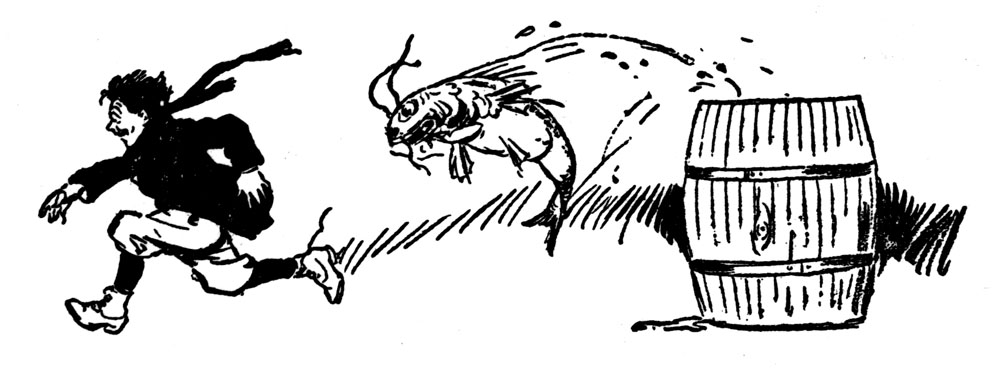 Don Marquis’s wild imagination wasn’t limited to a cockroach with the soul of poet or an alley cat claiming lineage from Cleopatra. Consider his story of Mr. Hoskins, a bullhead catfish with an affinity for dry land. The following tale combines two fish stories that had appeared separately in Don’s Sun Dial column in The (New York) Evening Sun. Together, they became the preface to an imagined “book,” or package, of fish hooks, as presented in “Prefaces,” a 1919 collection of farcical introductions to books that never made it into print. “Prefaces” was a huge success, cementing Don’s reputation as one of the nation’s leading satirists. (The illustration above, by the great Tony Sarg, appeared in “Prefaces.”)
Don Marquis’s wild imagination wasn’t limited to a cockroach with the soul of poet or an alley cat claiming lineage from Cleopatra. Consider his story of Mr. Hoskins, a bullhead catfish with an affinity for dry land. The following tale combines two fish stories that had appeared separately in Don’s Sun Dial column in The (New York) Evening Sun. Together, they became the preface to an imagined “book,” or package, of fish hooks, as presented in “Prefaces,” a 1919 collection of farcical introductions to books that never made it into print. “Prefaces” was a huge success, cementing Don’s reputation as one of the nation’s leading satirists. (The illustration above, by the great Tony Sarg, appeared in “Prefaces.”)
PREFACE TO A BOOK OF FISHHOOKS
By Don Marquis, from “Prefaces” (D. Appleton and Company, 1919)
This little book of flies and hooks and guts and hackles, which was presented to us by a friend who heard us say we liked to go fishing—we may as well admit at once that it is full of riddles we cannot rede. We know nothing about trout, and have no great ambition to learn. Fishing for trout has too much exertion and bodily effort about it to be attractive. One tramps about over rough country and gets one’s self wet in cold water, and tangles one’s hook in one’s hair and ears, and all that sort of thing.
Our idea of fishing is to put all the exertion up to the fish. If they are ambitious we will catch them. If they are not, let them go about their business. If a fish expects to be caught by us he has to look alive. We give him his opportunity, and he must make the most of it.
Most of our fishing, and the only fishing we ever really enjoyed, was done with a worm, a hook, a leaden sinker, a line and a willow pole. We wouldn’t know what to do with a reel. We expect a fish to eat the hook very thoroughly, to persist until he gets it well down and then to signal us that all is well by pulling the float under water; a reel is superfluous; one flips the pole over one’s head and the fish lands somewhere in the bushes behind.
A little quiet river or a creek, with low banks and plenty of big trees along the banks, is the only place to fish; and the fish should be mostly bullheads. Bullheads know their business; they hook themselves more completely and competently than any other fish. A bullhead will swallow the worm, the hook, and the lead sinker, a part of the line, and then grumble because he hasn’t been able to eat the float and the pole. And you can leave it all up to him. You can sit in the shade and watch the float bobbing and jerking about in the serene consciousness that he will do a good job. When he pulls the pole itself out of the socket of earth into which you have jabbed the butt end of it, then is the time to interfere and bring him. to land. Don’t hold the pole yourself; it is too much trouble.
Being out of the water doesn’t make much difference to the average bullhead. We don’t suppose he could stand it more than two or three days, unless there was a damp wind blowing, but a few hours more or less are nothing to him. After having eaten as much of your fishing tackle as you will permit him to have before interfering, you might think that he would be a little dejected. But not so. You go to take the hook out of him, and he rushes at you and horns you, with a queer purring noise, and shows every disposition to fight it out on land.
And he seldom knows when he is dead. Often in the course of a day we have caught a bushel or so of bullheads and thrown them into the back of the buggy and driven home with them, five or six miles, maybe. Arrived at home we would find them stiff and caked with dried mud and dust, and to all appearances dead, having been out of the water and jogging along in the hot afternoon sun for a couple of hours. But throw them into a barrel of water, and in a few minutes they were swimming around as if nothing had happened, grinning over the top of the barrel and begging for more worms and hooks and lead sinkers. Refreshed by his cool plunge, the beast was ready for another romp. The bullhead is not a beautiful fish, and has no claims to aristocracy, but he is enduring.
We never liked to fish from a boat. You have to row the thing about, and that is a lot of trouble. Select a big, shady tree that bends over a pool in some little inland stream and lie down under the tree, and lie there all day and fish and eat and smoke and chew tobacco and watch the dragonflies and spit into the water. If you feel like swimming a little, all right—it doesn’t particularly bother the bullheads. But it is a mistake to go to sleep.
If you go to sleep while you are loafing, how are you going to know you are loafing? And if you don’t know it, what satisfaction is there in it? And it is also a mistake to think too deeply. If you do that, about the time you begin to get on the track of the secret of the universe some fool fish will hook himself, and you will have to attend to him.
Lie with your hat over your face and watch thoughts carefully from under the brim of it as they come toward you out of the woods or up the creek. And if a thought that seems as if it were going to be too profound or troublesome tries to crawl up on you shoo it away and wait for an easy thought. And when you get an easy thought hold on to it and think it for a long time and enjoy it.
The best thoughts to have when you are fishing are the thoughts about what you would do if you had a million dollars. After a while you get sort of lenient toward the world, and unambitious, and think it’s a little selfish of you to want a whole million, and say “Shucks! I’d be willing to take a hundred thousand!” And you think maybe if you roused up a little and looked over the edge of the bank you would see a streak of gold in the soil, and then you would go and buy that land of the farmer that owns it and get rich off of the gold. And then you remember that you don’t know who owns the land and it would be considerable trouble to have to ask questions around and find out. So it doesn’t seem worth while to look over the edge of the bank and see whether the gold is there after all. And, anyhow, would it be fair, to whatever farmer owns the land, to buy it knowing there was gold on it and never tell him? And what would you buy it with? If you borrowed money to buy it with the fellow you borrowed the money from would likely get the biggest part of it, and you would have all your work and worry for nothing, and so you don’t look to see if the gold is there. And then you get to thinking that probably there aren’t many people honest enough to pass up a fortune like that just simply because somebody else owns it and you admire yourself for being that honest.
You can find more things to admire yourself for, lying around fishing like that, if you pick your thoughts properly. Everybody ought to do it all the time and not work at anything else.
* * *
Several friends and literary advisers to whom we have shown the foregoing preface have taken the trouble to intimate that they do not believe what we have said concerning the fish known as the bullhead; namely, that he can live out of water for several hours. This only shows how little some people know about bullheads. We might have told a story of a particular bullhead far more incredible, and equally true, but that we are aware of this general lack of exact information concerning bullheads and did not care to have our statements questioned by the ignorant.
This particular bullhead we caught and tamed when we were about twelve years old, and named him Mr. Hoskins because of his facial resemblance to a neighbor. Mr. Hoskins—-not the fish, but the fish’s godfather—had fallen from a windmill in youth, upon his head, and his head had been getting larger ever since, until he seemed all head, with a few wiry spikes of beard and mustache around his mouth. His intellect had not grown as his head grew; the poor man used to go about calling attention to his large head, saying: “I fell off a windmill and the hogs ate me, all but my head—see my head!” He was pathetically proud of it. The fish looked like him, and with the heedless cruelty of boyhood we named the bullhead Mr. Hoskins.
Mr. Hoskins (the fish) dwelt in an old wash boiler under a maple tree. And it was beneath this maple tree that we used to feed all our other animals every morning—a black dog, a crow, a black and orange cat, a brown dog called Gustavus Adolphus after the Terrible Swede of that name and an owl known (for we had been reading Dumas) as the Duchess de Montpensier. At that time, and in that place, the village butcher would give one a whole basketful of scraps and bones for a dime; the dogs, the cat, the crow and the Duchess would range themselves, solemnly expectant, in a row under the maple tree and catch the bits of meat we tossed to them in their mouths or beaks, no animal stepping out of his or her place in line and no animal offering to bite or peck its neighbor.
Mr. Hoskins, the bullhead, would come to the surface of the water and peer with one eye over the rim of the boiler, watching these proceedings closely. At first he watched them grouchily, we thought. A bullhead, however, is somewhat handicapped in the expression of the lighter and gayer emotions; his face is so constructed that even if he feels otherwise than gloomy and ill-humored he cannot show it. But as the spring wore into summer it seemed to us that Mr. Hoskins was getting friendlier, somehow. One day we tossed him a piece of meat and he snapped at it. After that we ranged the other beasts in a circle around the wash boiler, and if Gustavus Adolphus or the Duchess de Montpensier missed a piece of meat it fell to Mr. Hoskins. In ten days Mr. Hoskins could catch as well as any of them.
One morning we were alarmed to see that Mr. Hoskins’s boiler had been overturned during the night, no doubt by some thirsty cow. He seemed dead when we picked him up and we dug a hole in the ground and threw him into it. But before we had him covered a sudden summer rain came up and we sought shelter. It was a drenching rain; when it was over, a couple of hours later, we returned to Mr. Hoskins to find the hole filled with water and him flopping around in it. He was evidently feeling quite chipper, and was contentedly eating an angleworm.
We put him back in his boiler.* And then we began to experiment with Mr. Hoskins. If he could live out of water for two or three hours, why not for a whole day? Every morning we took him from his boiler at a certain time, and each day we kept him from the water ten minutes or so longer than the day preceding. By September he was able to go from seven in the morning until eight in the evening entirely out of water without suffering any apparent ill effects except a slight loss in weight. At first during the hours when he was out of water he would seem rather torpid, in fact almost comatose. But by giving him frequent cool drinks from a bottle with a quill in it we found that he became livelier. By autumn he could go until sunset on not more than two drinks of water.
He became a jollier companion, joining, so far as he was able, ourself and the other animals in all our sports. One of the most pleasant recollections of our boyhood is the memory of Mr. Hoskins flopping genially about the garden while Gustavus Adolphus and the other dog dug angleworms for Mr. Hoskins and the crow.
When the chilly weather came in November we moved his wash boiler into the house and set it behind the kitchen range, as we did not care to run the risk of having him frozen. But with the cold weather his need for water grew less and less; he began to manifest something like pride in his ability to do without it; it was in January that he began to experience, or at least to affect, a repugnance toward being in water at all. Then we substituted for the boiler a box full of sawdust. Still, however, even during January he would sometimes awake during the night and cry for a drink, and we insisted on a weekly bath.
At seven o’clock on the morning of St. Valentine’s Day, 1890, we went into the kitchen and found that Mr. Hoskins had leaped from the floor to the hearth of the kitchen range, and had succeeded in working himself in among the warm ashes. He had felt cold during the night. After that we always put him to bed with a hot water bottle, and we remember well his cries of peevishness and discomfort on the night when the stopper came out of the bottle and drenched him.
We linger over these last days of February, hesitating to go on, because they were the last days in Mr. Hoskins’s life. It was on February 28 that he went out of doors for the first time that year. Some one had left the cistern uncovered and he fell in. We heard his cries. We put a ladder down and plucked him from the black water. But it was too late. If he had only remembered how to swim, if we had only had the presence of mind to fling down a plank to him he might have kept himself afloat until we reached him with the ladder. But it was too late. We suppose that when he felt himself in the water a panic struck him. Those were days before every family had a pulmotor. We worked over him, but it was no use. It is silly perhaps to feel so badly over a little animal like that, but from that day to this we have never eaten a bullhead.
———-
* The star marks the exact spot at which the more skeptical sort of person will likely cease to believe.
‘A Chance for Mr. Carnegie’
From the very beginning, Don Marquis used his newspaper column to poke fun at the rich and powerful, and proof of that claim can be found in The Evening Sun of April 12, 1913. Don’s Sun Dial column on that day wasn’t even a week old (it had debuted on April 7) when he aimed his wit at one of the richest and most powerful men in the world: Andrew Carnegie. The famed industrialist, founder of the largest iron and steel operations ever owned by an individual in the United States, was, by 1913, giving away hundreds of millions of dollars in a well-publicized rush of philanthropy. Carnegie enjoyed telling stories of his humble childhood in his native Scotland, and of the hard work and determination that brought such wealth to him and, by extension, his adopted home town, Pittsburgh — a city where the smokestacks from Carnegie’s factories turned the noonday sky dark with soot.
Here is an extract from Don’s column of April 12, 1913:
A Chance for Mr. Carnegie
Mr. Andrew Carnegie says, “I would have liked to be a reporter. I tried my best once in Pittsburg to get on a paper, but they wouldn’t have me.”
We are afraid we can’t promise our assistance in getting anything in the news end of a paper for Mr. Carnegie, although we hate to discourage a worthy young man who is trying to better himself. The dull season is coming along pretty soon, anyhow.
But if Mr. Carnegie will drop in to see us any afternoon from 3 to 5, with a letter from his pastor, we will outline to him an arrangement we have in mind whereby he can write short pieces for this column now and then. Let him wear a carnation in his coat lapel and look about him for an average looking sort of a person with an ordinary necktie in plain clothes, and we will know each other at once.
We have the thought of making a poet out of Mr. Carnegie. A stanza of his earlier verse floated into our notice some years ago, and we said at once: “Here is a man with a talent: if he only received proper encouragement he might get ahead in the world.” But evidently no one encouraged Mr. Carnegie. The stanza to which we refer is as follows:
Mary had a little lamb,
Its fleece was white as snow,
It followed her to Pittsburg –
And look at the d—d thing now!
The words “snow” and “now” are both to be pronounced so as to rhyme with the word “gnu.”
It will be a rather arduous apprenticeship, and for a while Mr. Carnegie will have to submit to having his best things published over our signature, but if he works hard (crushing, among other things, the slight tendency to profanity which mars the above quatrain), we will give him a start.
After that, it’s up to him.
A Marquis Family Album
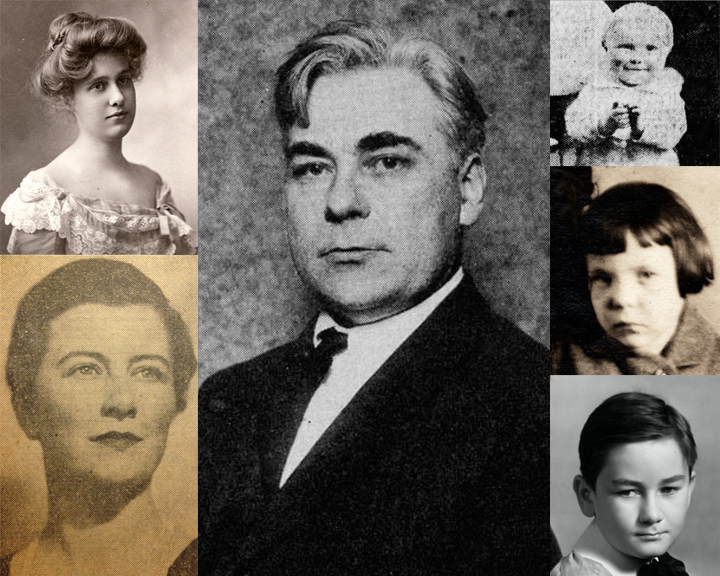 Here is a look at Don Marquis and the most important people in his life: his family. His first wife, Reina, is at the top-left, in a photo from the first decade of the last century. It was taken in Atlanta, at about the time she met a young up-and-coming writer who bought several of her short stories for a new magazine he was editing, Uncle Remus’s Magazine. Their children, at top-right, were Bobby (above) and Barbara (below). Reina died unexpectedly in 1923, and two years later Don married Marjorie Vonnegut, lower-left, an accomplished Broadway actress. Don helped raise Marjorie’s son from a previous marriage, Walter Vonnegut, lower-right, know to his family as Colonel. Tragically, Don saw everyone but Walter die before his own pitiable death in 1937, at age 59, after a succession of strokes. Bobby died in 1921 at age 5, two years before his mother. Barbara — the adored “babs” to whom Don dedicated “archy and mehitabel” in 1927 — had always been a sickly child; she was 13 when she died in 1931. And Marjorie, who drove herself to exhaustion caring for Don in his final years, died in her sleep in 1936. Walter, however, lived for many decades beyond. He was 90 when he died in 2013. To the end, he fondly recalled his childhood with “Uncle Don.”
Here is a look at Don Marquis and the most important people in his life: his family. His first wife, Reina, is at the top-left, in a photo from the first decade of the last century. It was taken in Atlanta, at about the time she met a young up-and-coming writer who bought several of her short stories for a new magazine he was editing, Uncle Remus’s Magazine. Their children, at top-right, were Bobby (above) and Barbara (below). Reina died unexpectedly in 1923, and two years later Don married Marjorie Vonnegut, lower-left, an accomplished Broadway actress. Don helped raise Marjorie’s son from a previous marriage, Walter Vonnegut, lower-right, know to his family as Colonel. Tragically, Don saw everyone but Walter die before his own pitiable death in 1937, at age 59, after a succession of strokes. Bobby died in 1921 at age 5, two years before his mother. Barbara — the adored “babs” to whom Don dedicated “archy and mehitabel” in 1927 — had always been a sickly child; she was 13 when she died in 1931. And Marjorie, who drove herself to exhaustion caring for Don in his final years, died in her sleep in 1936. Walter, however, lived for many decades beyond. He was 90 when he died in 2013. To the end, he fondly recalled his childhood with “Uncle Don.”
The Don Marquis Double Scotch and Prohibition Society
 Stories of Don Marquis sharing drinks and tall stories with his friends are legion. He was a regular at The Players club in New York and other clubs and taverns throughout the 1920s and ’30s, where invariably he was at the center of spirited talk. That camaraderie seems in short supply in our busy modern world, but there’s something we can do about it. And so we propose a new club for today’s legion of Don Marquis fans.
Stories of Don Marquis sharing drinks and tall stories with his friends are legion. He was a regular at The Players club in New York and other clubs and taverns throughout the 1920s and ’30s, where invariably he was at the center of spirited talk. That camaraderie seems in short supply in our busy modern world, but there’s something we can do about it. And so we propose a new club for today’s legion of Don Marquis fans.
Introducing the Don Marquis Double Scotch and Prohibition Society!
The name borrows from a story recounted by Don’s biographer, Edward Anthony, in his 1962 book, “O Rare Don Marquis,” in which Don, after an extended period of abstinence, boldly walked up to the bar at The Players and declared, “I’ve conquered that goddamn willpower of mine. Give me a double scotch!”
There are other literary clubs and groups focused on the 1920s era, of course. The Dorothy Parker Society calls itself a drinking club with a literary problem, and there’s also the Robert Benchley Society, the scholarly Fitzgerald and Hemingway societies, and the marvelously magnanimous Repeal Society, to name a few. But the Don Marquis Double Scotch and Prohibition Society is our own excuse to gather and talk and drink and talk and tell stories and talk some more.
The bylaws of the Society are straightforward. Basically, if you want to join the Society, you just did. And anywhere that you and a friend raise a toast to Don constitutes a meeting of the local chapter.
Please forward your name, contact information and anything else you’d like to say to John Batteiger, founder of the Society, at john(at)donmarquis.com. We will add you to the roster and keep you informed of Society news and cocktail hours. Also, please visit our website at www.donmarquis.com and the Facebook page at www.facebook.com/DonMarquisAuthor.
Chapter secretaries (that means you) will take note of the following administrative files:
— Bylaws of the Society
— Society logo
— Letterhead for official Society correspondence
— A photo of Don
— ‘Who the Hell Is Don Marquis?’ *
But enough formalities. Let’s end with a toast: Cheerio my deario!
* This line, by the way, comes from the title of a slim tribute volume privately published in 1998 by the late Steve Gatensbury of British Columbia. We regret the Society had not been founded in time for Mr. Gatensbury to have been a member.
Don Marquis Joins New York State Writers Hall of Fame
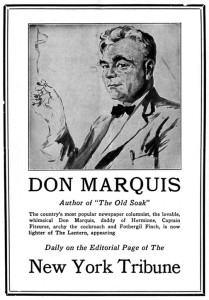 It was a thrilling night at Manhattan’s 3 West Club on Tuesday, June 7, as Don Marquis and seven other literary greats were inducted into the New York State Writers Hall of Fame at a gala dinner hosted by the Empire State Center for the Book and the New York Library Association.
It was a thrilling night at Manhattan’s 3 West Club on Tuesday, June 7, as Don Marquis and seven other literary greats were inducted into the New York State Writers Hall of Fame at a gala dinner hosted by the Empire State Center for the Book and the New York Library Association.
Don joined Roger Angell, Roz Chast, Samuel R. Delany, Stephen Sondheim, Maya Angelou, Jean Craighead George, and Grace Paley as 2016 honorees. Sixty-six writers have been inducted into the Hall of Fame since its founding in 2010 by the Empire State Center for the Book, including Walt Whitman, Herman Melville, Washington Irving and Frederick Douglass. Twentieth-century writers in the Hall of Fame include John Cheever, Toni Morrison, E.B. White, Dorothy Parker, James Thurber, Kurt Vonnegut, Nora Ephron, Calvin Trillin and Joyce Carol Oates.
Rocco Staino, director of the Empire State Center for the Book, presided over the Hall of Fame gala. Don’s award, a Lucite plaque mounted on polished wood, was accepted by John Batteiger, creator and editor of DonMarquis.com. Here is a transcript of Batteiger’s induction tribute:
* * *
DON MARQUIS once griped to a reporter that after 30 years as a newspaper columnist, poet, short-story writer, novelist and playwright, he would probably be remembered as “the creator of a goddamn cockroach character.”
He was right, of course. “archy and mehitabel” — his lowercase stories of a cockroach with the soul of a poet and an alley cat dancing through her ninth life — remains a classic of American literature. The book has never been out of print since it first appeared in 1927 – more than 100 printings, by my count — and its stories are in virtually every anthology of American humor.
Not his five novels, not his three volumes of serious poetry, or his four Broadway plays – 29 books in all. And that’s not counting the four Hollywood movies and five radio and television dramas based on his work. No, we know Don Marquis best for “archy and mehitabel” – wild bits of fantasy that helped make him one of the most famous writers in America in the years before and after World War One – before the wits of the Algonquin Round Table and the New Yorker magazine gained prominence, and before the writers of the Lost Generation found their voice.
Archy and Mehitabel, by the way, were first conceived just over 100 years ago – in March, 1916 – to fill space in Don’s six-day-a-week newspaper column in the New York Evening Sun. Filler material has never had such staying power.
But I’m certain Don would be extremely proud to accept this honor. Every journalist dreams of being remembered for something more than yesterday’s headline and tomorrow’s fishwrap. In Don’s case, the successful comic, the beloved humor writer always wanted to be taken seriously.
Sadly, Don Marquis has no family left to claim this Hall of Fame honor. Both of his wives and both of his children died before his own passing in 1937. Don’s stepson, Walter Vonnegut Jr. – a cousin of Kurt Vonnegut, by the way – died three years ago at the age of 90.
Me, I’m a stand-in. I am wrapping up work on a bibliography of Don’s writings, and I edit a website and a Facebook page that reprint some of his tall tales and light verse and tell stories about his life.
To most Americans of the 1920s and ‘30s, Don Marquis was the consummate New Yorker – suave, clever and successful. But Don was born and raised on the Illinois prairie. He arrived in New York in 1909 and got his first solid job in New York on the staff of the Brooklyn Eagle, a storied newspaper that had once employed another future member of the New York State Writers Hall of Fame – Walt Whitman.
After a year Don left the Eagle to make a name for himself on the New York Evening Sun, where he created his famous characters Archy and Mehitabel, along with The Old Soak, and Hermione and her Little Group of Serious Thinkers. Don’s last newspaper job was at the New York Herald Tribune, working out of its offices at 219 West 40th Street. Today that building is the home of the CUNY Graduate School of Journalism.
I don’t know for sure if there are any ink-stained ghosts in the CUNY classrooms, but I do know that Don Marquis always warmly regarded his colleagues in that building. And so it seems appropriate that Don’s Hall of Fame award find a home there.
I’d like to introduce Andrew Mendelson, associate dean of the graduate school of journalism, and Tim Harper, adjunct professor and editor of the CUNY Journalism Press. I talked with Dean Mendelson, and he told me that the school would provide a home for this award there on West 40th Street. By doing so, they will make one old ghost very, very happy. Thank you very much.
— John Batteiger



